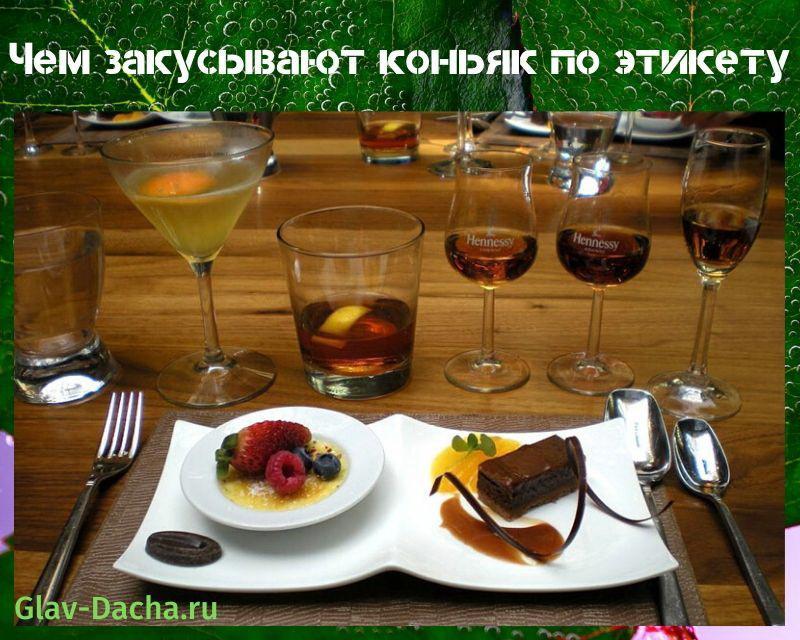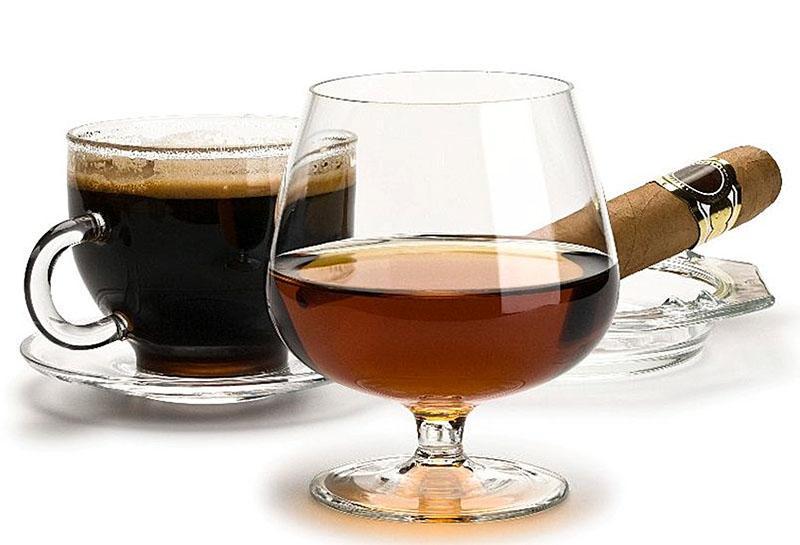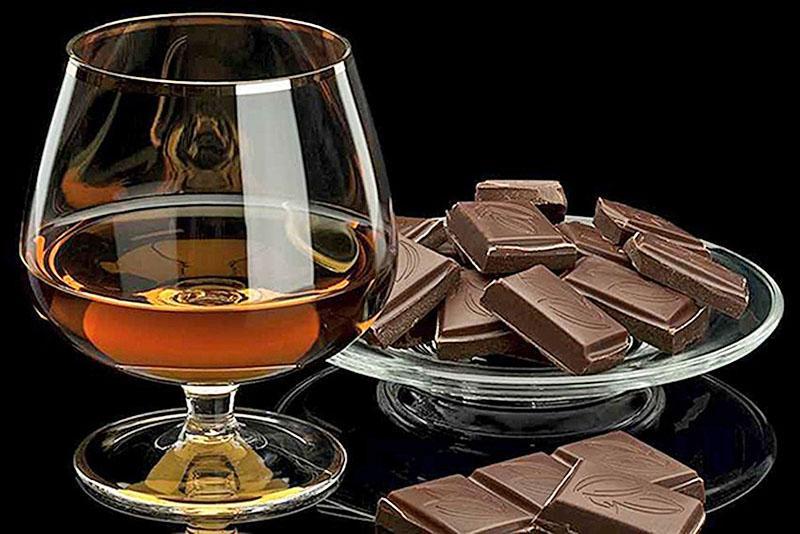How to eat cognac according to etiquette
 Cognac is an exquisite and prestigious drink. An important point of its correct use is the choice of what cognac is eaten with. After all, accompanying dishes and drinks can both emphasize and even out its taste and aroma. Therefore, in order to experience all the charm of the "golden wine" made from white grapes, it is enough just to choose the right snack (see. buffet snacks, simple and tasty - recipes with photos).
Cognac is an exquisite and prestigious drink. An important point of its correct use is the choice of what cognac is eaten with. After all, accompanying dishes and drinks can both emphasize and even out its taste and aroma. Therefore, in order to experience all the charm of the "golden wine" made from white grapes, it is enough just to choose the right snack (see. buffet snacks, simple and tasty - recipes with photos).
The history of cognac production began in the French town of the same name at the end of the 17th century. It was then that the first producers discovered that the quality of cognac distillate (alcohol) significantly improves after its storage in oak barrels. This is how the concept of aging appeared - one of the most important in technology. In the region of the city of Cognac, a tough production technology of this noble drink has been preserved. It is produced in an unchanging way from special grape varieties and on specific equipment. The region retains the exclusive right to the name of the drink of which it is home.
How to choose and drink cognac correctly

For such cognacs, gourmets recognize only the 3C rule in two variations - Cafe (coffee), Cognac, Cigare (cigar) or Cafe, Cigare, Chocolat (dark chocolate). After drinking an afternoon cup of coffee, they take a few sips of brandy, after which they smoke a cigar. Non-smokers replace it with a few pieces of dark chocolate.
Cognac is supposed to be drunk in comfortable spherical glasses with a wide base - "snifters" (from English to shiff - "to sniff"). The tapered top contributes to the preservation of the aroma of the drink and its gradual release. Such glasses can be decorated with gilding and inlay.
 Tulip-shaped glasses are much less common. Classic cognac glasses are also suitable for checking the age of cognac in doubtful cases. To do this, you need to twist the glass around its axis. If the drink flows down the walls for 5 seconds, then its exposure is 5–8 years. A time of 15 seconds indicates a 20 year exposure. Elite cognacs flow down the walls of the glass for at least 17 seconds.
Tulip-shaped glasses are much less common. Classic cognac glasses are also suitable for checking the age of cognac in doubtful cases. To do this, you need to twist the glass around its axis. If the drink flows down the walls for 5 seconds, then its exposure is 5–8 years. A time of 15 seconds indicates a 20 year exposure. Elite cognacs flow down the walls of the glass for at least 17 seconds.
Classic cognac ceremony

Cognac etiquette evokes associations with the Chinese tea ceremony. It is based on several fundamental rules:
- Cognac bottles are stored in a protected from the sun only in an upright position so that the cork does not touch the drink. Long-term contact with air does not benefit the cognac, therefore it is recommended to pour the cognac from a half-empty bottle into a tight-fitting decanter.
- The tasting is held in a special small room such as a living room or study. It is desirable to have comfortable chairs and a table for a drink and glasses in the room.
- The optimum temperature for use is at room temperature. Cognac needs neither cooling nor heating.
- The glasses are about a quarter full. It is customary to hold them so that the leg passes between the ring and middle fingers.
- Enjoying cognac begins with admiring its amber tones.
- The first wave of vanilla cognac scent is felt about five centimeters from the edge of a quarter-filled glass. When he approaches, it is replaced by aromas of fruits and flowers. After taking a sip of the drink, the port tones already feel the taste buds.
- Continuation of use - only in small sips, savoring the taste. This is the only way to feel the aftertaste on the tongue and throat. It is the longer, the higher the quality of the cognac. The preferred time of consumption is after lunch. The cognac taken at this time, in addition to pleasant emotions, promotes the assimilation of food.
How to eat cognac in Russia and other countries
 Along with the elite cognac, used as part of the afternoon dessert, there are cognac and brandy of moderate aging, served with buffets and feasts. What can be served with such cognac?
Along with the elite cognac, used as part of the afternoon dessert, there are cognac and brandy of moderate aging, served with buffets and feasts. What can be served with such cognac?
Buffets
 Traditional buffet snacks - hard cheeses, seafood, olives, dried fruits, white meat, salmon, canapes with caviar, vegetable salads in vegetable oil, go well with cognac.
Traditional buffet snacks - hard cheeses, seafood, olives, dried fruits, white meat, salmon, canapes with caviar, vegetable salads in vegetable oil, go well with cognac.
It is no coincidence that cheeses were mentioned first, they emphasize the flavor of the drink in contrast and prevent the addiction of taste buds. This allows the scent period to be extended.
 From hot dishes, lean white meat is appropriate - poultry, game and veal. A prerequisite for cooking is moderate pungency and spice so as not to distract from the taste of cognac. From fruits, pears, apples are recommended, Strawberry and grapes grown in the region of cognac production. The producers of the best cognac in the post-Soviet space are Armenians; they prefer peaches to other fruits.
From hot dishes, lean white meat is appropriate - poultry, game and veal. A prerequisite for cooking is moderate pungency and spice so as not to distract from the taste of cognac. From fruits, pears, apples are recommended, Strawberry and grapes grown in the region of cognac production. The producers of the best cognac in the post-Soviet space are Armenians; they prefer peaches to other fruits.
By the way, about the Armenian brandy. They say that British Prime Minister Winston Churchill, who became addicted to him during the Yalta Conference, was a big fan of him.
Once, after the war, Churchill complained to Stalin that the taste of his favorite brandy, Dvin, had deteriorated. Stalin was informed that the creator of almost all brands of Armenian cognac, Markar Sedrakyan, had been exiled ... to Odessa, where he worked at a local brandy factory.
The leader ordered to immediately return the master to Yerevan. The taste of Churchill's beloved cognac was restored, and Sedrakyan's labor activity was crowned with the title of Hero of Socialist Labor. He also received the highest award of the French cognac house "Camus".
How to eat cognac at feasts
 The situation with feasts is more complicated. Tasteless vodka goes well with the prevailing fatty and spicy dishes, but not refined cognac. A worthy setting is poultry, rabbit or veal dishes and seafood. From drinks - grape juice, dry white wine and still mineral water, but not Coca-Cola or citrus juices.
The situation with feasts is more complicated. Tasteless vodka goes well with the prevailing fatty and spicy dishes, but not refined cognac. A worthy setting is poultry, rabbit or veal dishes and seafood. From drinks - grape juice, dry white wine and still mineral water, but not Coca-Cola or citrus juices.
 In Russia, such cognac is most often accompanied by lemon and its variations. It is believed that this tradition was laid by the last Russian emperor. At the court of Nicholas II, sliced lemon slices were sprinkled with powdered sugar, bitter chocolate and coffee and combined with black caviar, nuts and cheeses. Popular was the "hussar sandwich" of two pieces of cheese with a slice of lemon in between. Modern followers of the imperial tradition use mild cheeses such as Mozzarella or Gouda. Sometimes cheese slices are grated and mixed with honey.
In Russia, such cognac is most often accompanied by lemon and its variations. It is believed that this tradition was laid by the last Russian emperor. At the court of Nicholas II, sliced lemon slices were sprinkled with powdered sugar, bitter chocolate and coffee and combined with black caviar, nuts and cheeses. Popular was the "hussar sandwich" of two pieces of cheese with a slice of lemon in between. Modern followers of the imperial tradition use mild cheeses such as Mozzarella or Gouda. Sometimes cheese slices are grated and mixed with honey.
 In addition to fresh lemon, caramelized lemon circles are used. They are boiled for an hour in syrup made from equal parts (300 g each sugar and water). The taste of such circles is much weaker than fresh ones, and does not interrupt the cognac aroma.
In addition to fresh lemon, caramelized lemon circles are used. They are boiled for an hour in syrup made from equal parts (300 g each sugar and water). The taste of such circles is much weaker than fresh ones, and does not interrupt the cognac aroma.
However, the prevailing opinion among experts is that the combination of any lemon combinations with high-quality cognac is absolutely unacceptable. An exception is made for ordinary cognac.
Cocktails
 From the middle of the XX century. the use of diluted cognac became somewhat widespread.Strictly speaking, an expensive drink is not a very good ingredient to dilute. This option, however, is convenient for people who avoid hard alcohol.
From the middle of the XX century. the use of diluted cognac became somewhat widespread.Strictly speaking, an expensive drink is not a very good ingredient to dilute. This option, however, is convenient for people who avoid hard alcohol.
The most popular "Champagne cocktail" contains a mixture of:
- 100 g of champagne;
- 20 ml of brandy;
- a lump of brown sugar;
- a few drops of Angostura bitter.
Cooking begins by soaking the sugar with the infusion at the bottom of the glass. Then cognac is poured into it first, and then - champagne. The role of the "cherry on the cake" can be played by an orange slice.
 In an ordinary shaker, you can make a Honeymoon cocktail. To prepare it, 10 ml of French Cointreau orange liqueur and white wine are mixed with 40 ml of cognac.
In an ordinary shaker, you can make a Honeymoon cocktail. To prepare it, 10 ml of French Cointreau orange liqueur and white wine are mixed with 40 ml of cognac.
Among hot cocktails, coffee is common, for a cup of which two teaspoons of brandy and a teaspoon of sugar are added.